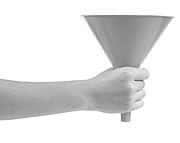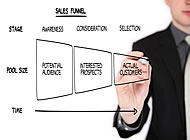 A customer (also known as a client, buyer, or purchaser) is usually used to refer to a current or potential buyer or user of the products of an individual or organization, called the supplier, seller, or vendor.
A customer (also known as a client, buyer, or purchaser) is usually used to refer to a current or potential buyer or user of the products of an individual or organization, called the supplier, seller, or vendor.
These are not my words but the definition of the word “customer” according to Wikipedia. In practice, we refer to a customer as someone who has bought something from our company. The potential buyer is called a lead, prospect, suspect and about a gazillion other things, depending on whom you talk to.
Look up the definition of a prospect and you’ll find different explanations. In many businesses, a proprietary term is used (not seldom depending on the used CRM tool) and, unfortunately within one business you will often notice that several departments and even individuals within them don’t use the same definition.
Do our lead nurturing activities correspond with reality?
Traditionally, we look at the customer journey, the buyer’s journey, the sales/buying process and lead management/nurturing from the good old funnel perspective we often still use in marketing automation and conversion optimization, for instance. In practice, the funnel doesn’t look as the nice, inverted pyramid – or any other variant- we all know. It looks more like a very badly drawn inverted pyramid with several entry and exit points, bulges filled with people that might never buy but are interacting with us, anyway, because they like our content, email newsletters, social media marketing activities and whatnot.
For acquisition, and thus ROI purposes, we mainly look at the different traditional stages in the funnel: what goes in and what comes out. What comes out are customers, and once we have those, we work hard on retention and loyalty because we know that satisfied customers and brand advocates, lead to acquisition. Word of mouth, influence, referrals and much more as the best, fastest and most effective way to acquire new customers, remember?
The traditional funnel model really is a simplification of reality. Truth is that people can become customers in every stage of the funnel. As a matter of fact, they often become customers without ever having entered the funnel.
And what about all those subscribers to our newsletters, people who download our papers, social media fans and followers, that often reside in protrusions we sometimes can identify and sometimes not or hardly. You can, for instance, identify the subscribers to your emails and the fans of your Facebook page but how much do you know about them? And do you know anything at all about the communities around your brand, content or fans and subscribers?
When we talk about lead nurturing, we decide who we focus on (using lead scoring and defining rules such as “minimum x employees” or “expressed buying interest”) but does that correspond with reality?
Nurturing fans, connections and social ecosystems
 In the end, by doing this, we look at conversion and potential customers, from our perspective. It’s important to do this but doing only that makes us miss out on many opportunities.
In the end, by doing this, we look at conversion and potential customers, from our perspective. It’s important to do this but doing only that makes us miss out on many opportunities.
There are several ways we miss out on these opportunities and that show why retention is not only about customers and nurturing not only about acquiring customers.
One of them is misunderstanding customers in a connected age and ignoring the existence of social ecosystems.
I often use the word ecosystem. Simply said, an ecosystem is a set of relationships among living residents, resources and habitats of a specific area. Translate this to your business: an ecosystem is a living and changing entity, composed by all elements in and around your business. It includes your resources, channels, content, relationships and all people within and around your business, and it is connected with other ecosystems. It also includes customers and social spheres.
Redefining the customer and retention: social capital
What is a customer? It’s not only someone who buys something from you or might do so in the strict sense. Your employees are customers as well: they buy something from you and at the same time sell something to you. The same goes for your stakeholders, the media, etc. And obviously, the social connections you have are customers too: they are connected (via social, email, your blog, your white papers, etc.) with you for a reason, and they buy something as well, even if it’s a social or valuable good that doesn’t add to your revenue (often called social capital).
Fans, followers, subscribers and other connections, including their connections, are customers. They buy something from you in the broadest sense and sell you their trust and loyalty. However, they also sell your brand, directly or indirectly, to their own personal ecosystems, thus leading to sales.
Can you measure this? It’s hard but taking into account your sales cycles and other factors, the impact of every activity can be measured ultimately when looking at the bottom-line.
Let me give you an example of what I just explained. I am registered for newsletters of businesses, I’m not a customer of and I indirectly “sell” those businesses to others by saying how great their content is. Will I ever become a customer myself? Maybe, maybe not but it’s important I keep receiving that great content. My connections or theirs can become customers or serve another purpose.
Export this newsletter example to social media and customers in the broadest sense, think about the long tail and imagine the impact. So, don’t only nurture your (potential) customers in the strictest sense and don’t only nurture existing communities: think about the often invisible and forgotten connections and the mesh of personal social ecosystems as well. Think retention when interacting with them (directly and indirectly) as well.
The business impact of a customer who doesn’t buy
Furthermore, broaden the concept of a customer beyond people that actually buy (the bottom of the funnel). Just a few examples: what is the impact on your business of people that are not related or connected to you in a strict commercial sense when they blog about one of your papers or posts, when they bookmark something or share it?
Just think about the impact of a post on a good blog (good PageRank, etc.) on SEO and thus on the “strength” of your blog and website from an inbound marketing perspective (“being found”). What if that post gets shared a lot and leads to more posts or bookmarks, linking to your blog or website? What is the impact of someone receiving your emails, simply for the value of the content, and forwarding them to their connections? Notice how multichannel thinking and working is showing here, again.
Retention and loyalty are not only about customers. They are also about social and other connections. And they play a very important – and underestimated – role in acquisition as well. The way to think about them is, as always, not from a pure company centric and even immediate goal-driven perspective but from a people, multichannel and ecosystem centric view also.
There is much more than what happens in the funnel. Broaden your definitions of customers and don’t suffer from a narrow funnel vision or pure immediate and easily measurable goal-defined strategy, you’ll do better when understanding social ecosystems and how they work. Focus on keeping good connections: it’s retention as well.

